Disclosure: Please note that some links are affiliate links, and at no additional cost to you, we earn a commission if you make a purchase.
If you would like to support this website in some way, using these links will help do exactly that.
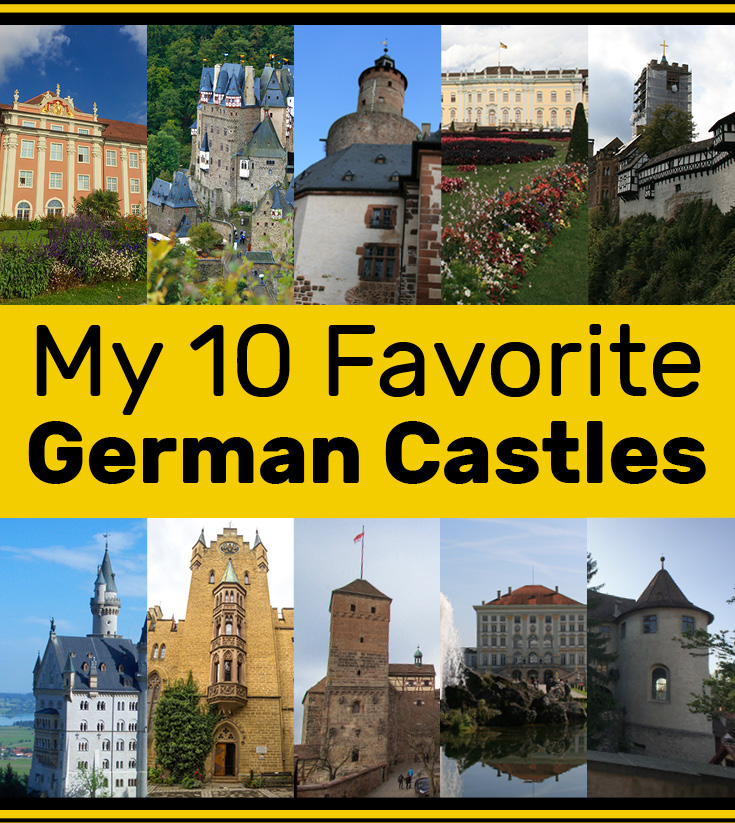
After pointedly seeking out as many castles as we could visit every year on our annual vacation for ten years, here are our top ten favorite German Castles & Palaces.
#10 Neues Schloss Meersburg | Meersburg, Germany
This beautiful palace overlooks Lake Constance, has beautiful gardens below, and I learned what a Prince-Bishop is. For more details on our experience, read our earlier article 'Crash Course in Prince-Bishops at the Neues Schloss Meersburg'.
#9 Schloss Buedingen | Buedingen, Germany
An intimate family castle where the residing Princess is listed as the emergency contact on the ticket office door. For more details on our experience, read our earlier article 'Buedingen Castle: Family Photos Beside Medieval Murals'.
#8 Burg Meersburg | Meersburg, Germany
As the oldest castle in Germany, this one already has bragging rights, but they’re well earned. This is a very approachable, relaxed castle experience with authentic furnishings and interesting ties to a famous German poet, Annette von Droste-Huelshoff. For more details on our experience, read our earlier article 'Germany's Oldest Inhabited Castle'.
#7 Nuernberger Burg | Nuremberg, Germany
A great castle to learn about the King Elector system of Germany, while it wasn’t a home base for any certain dynasty, the Deep Well demonstration is definitely worth the add-on cost and was Sebastian’s favorite part. For more details on our experience, read our earlier article 'What You'll See at the Imperial Castle of Nuremberg'.
#6 Schloss Neuschwanstein | Schwangau, Germany
This castle isn’t for the faint of heart as the tourist crowds are oppressive. Although the castle is unfinished and was barely lived in, what is complete is equally stunning as it is fascinating. Seeing the castle from the Marienbrücke (Queen Mary’s bridge) is a must. For more details on our experience, read our earlier article 'Touring Neuschwanstein Castle'.
#5 Residenzschloss Ludwigsburg | Ludwigsburg, Germany
During a time period when most courts wanted to emulate Versailles in France, this palace gets pretty close to the original. The guided tour experience was unique in that we saw hidden passageways used by the servants. This palace also boasts the oldest preserved theater in Europe. For more details on our experience, read our earlier article 'Touring Residenzschloss Ludwigsburg'.
#4 Burg Hohenzollern | Bisingen, Germany
I was intrigued by this monumental castle that looms dramatically above the surrounding area on its hill, cloaked in dense fog for dramatic effect. It has links to Prussian Queen Luise, my favorite monarch. She visited the castle and they have a few items of hers including a stunning gown in the treasury. This castle has survived battle and been rebuilt three times. For more details on our experience, read our earlier article 'Burg Hohenzollern, Inside and Out'.
#3 Burg Eltz | Wierschem, Germany
Like the castle in the opening scene of Beauty and the Beast, Burg Eltz sits nestled in a forested valley and will take your breath away at first glance. Guided tour only, and yet you still don’t feel like a tourist while visiting the intimate family rooms of this castle. Be on the lookout for the oldest Renaissance-period bed on display. For more details on our experience, read our earlier article 'Burg Eltz: Where Medieval Castle Fantasies are Fulfilled'.
#2 Wartburg | Eisenach, Germany
The most German of the German castles! What I really love about Wartburg is how much devotion to medieval architecture is in this castle. Where many cities tore down medieval buildings to replace it with the hipper styles of the day, the Wartburg’s medieval style was honored and even recreated in new buildings. The castle’s ties to the legend of St. Elizabeth, Martin Luther, Johann Wolfgang von Goethe, and German Unification makes it a must-see whether you fancy medieval castles or not. For more details on our experience, read our earlier article 'What You Need to Know Before Visiting Wartburg Castle'.
#1 Schloss Nymphenburg | Munich, Germany
This one really has it all for me; family feel and history, stunning interiors (bonus points for Rococo, my favorite), and sprawling gardens to get lost in. It was not overrun with tourist groups like Versailles (France) or Neuschwanstein (see #6 above), and we visited during Oktoberfest when the city of Munich was full of tourists. The final bonus that sealed Schloss Nymphenburg as my all time favorite German castle is the peculiar and fascinating Gallery of Beauties commissioned by King Ludwig the I. For more details on our experience, read our earlier article 'Schloss Nymphenburg and the Generations of Stories'.
Jump-Start Your Travel Plotting
Since you've made it this far, here's a bonus! We plotted our top ten favorite castles on a custom Google Map that you can use to start planning your trip.
Follow Along
If you enjoyed this article, or these topics sound interesting to you, you'll love our weekly newsletter. You'll receive the newest posts each week and exclusive access to free planning resources like ‘Packing List & Tips for 2 Weeks in Germany’ and ‘Everything You Need to Rent a Car in Germany’.
Thank you for reading!

Wartburg Castle is more than just a castle, it's a symbol of German unity, and sometimes called the ‘most German castle’, similarly to how (a previous post from us) St. Peter in Frankfurt is called the ‘most German church’. It's a fair assessment when you discover how much happened at this castle! Here are tidbits of history you need to know to get the most out of your visit of Wartburg Castle.
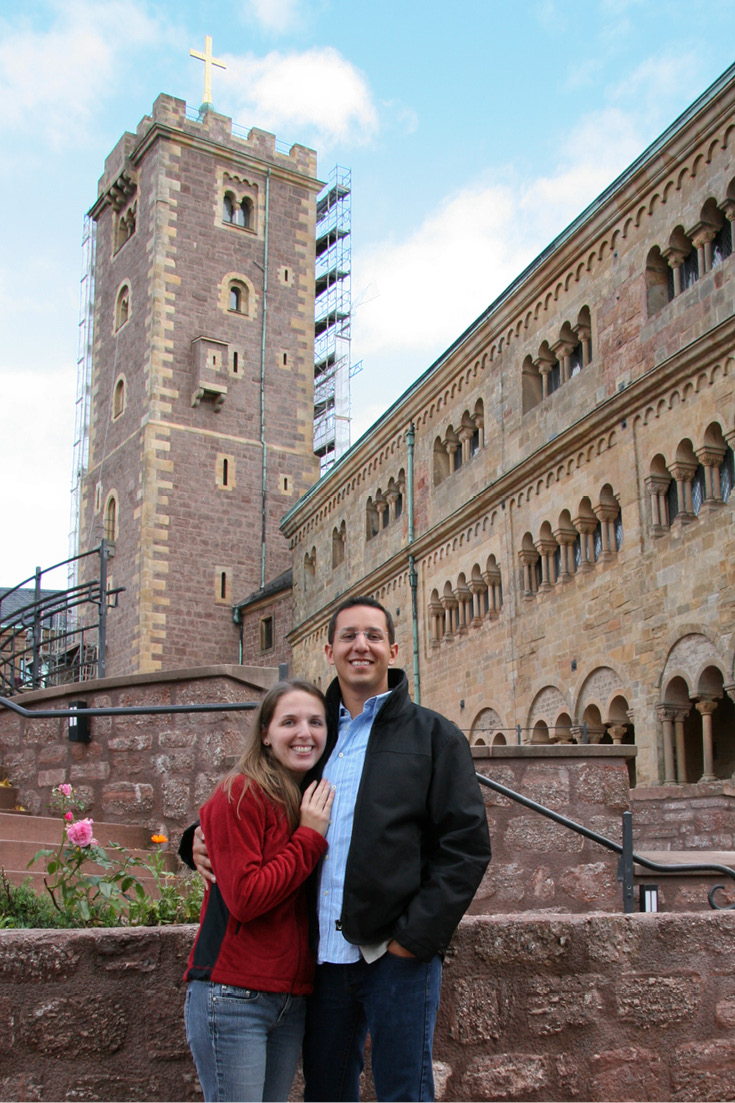
Medieval Hilltop Castle Architecture
Any self-respecting medieval castle is built on a hill, and Wartburg Castle is no different. Wartburg castle went through four periods of construction. Hang on to your chair, we’re also going to introduce German castle vocabulary words that might prove helpful during your visit. The German words, as always, will be italicized. The initial building period of the Palas (great hall building) was between 1157-1162. The Romanesque-period gate arch, located inside the Vorburg (front castle) is from 1200. The majority of the Vorburg, which includes the Ritterhaus (knight’s house), Torhaus (tower house), Vogtei (castle bailiff’s lodge), and the sentry walks are all timber framing and built in the late medieval time, 1478-1480. Finally, the last building period, the historicist (1853-1860), included the Bergfried (free-standing fighting tower), Neue Kemente (Fireplace Room), the Torhalle (porch), Dirnitz (heated hall building), Gadam (granary), and the Ritterbad (knight’s bath). During the historicist period the Palas was opulently furnished with the fantastical frescoes of Moritz von Schwind and the Festsaal (festival hall). In 1912-1914, the final addition of the Wartburg hotel was built.
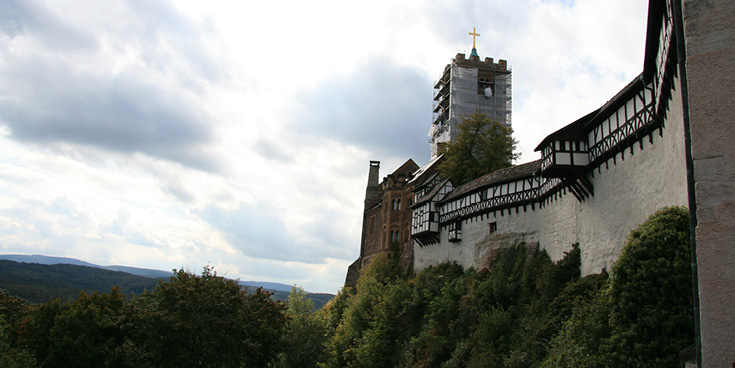
What is a Landgrave?
I wouldn’t be surprised if you had never heard of a landgrave before, which means ‘provincial count’. The title was first invented in 1131 solely for the German state of Thuringia, and intended to put landgraves on equal level with dukes, and ultimately could become imperial princes. Becoming a landgrave was in thanks for the dynasty’s help to Saxon Lothar von Süpplingenburg in the election of a king of Germany against Emperor Heinrich V.
If you ever wondered what your room would look like if you were a medieval princess, look no further! Named the Ruler’s Room, although the furniture is not original to the room itself, it's been collected, the effect is jaw dropping. The views of the Thuringia forest from the windows, to the chandelier and the stencil ceilings, it's decadent.
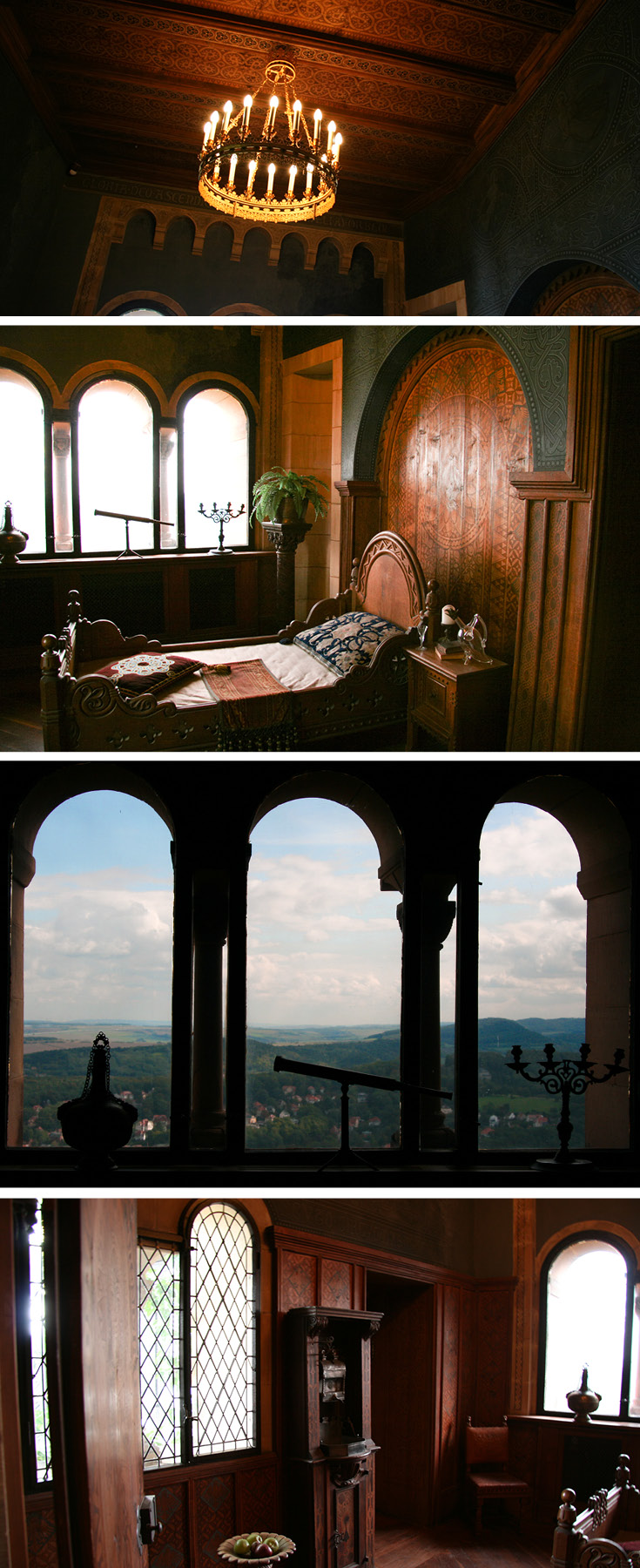
What are Minnesingers?
A minnesinger is a 12th-14th century German lyric poet and singer who performed songs of courtly love. All medieval courts had minnesinger contests, but it's alleged that Wartburg Castle held the most famous contest of the age with the six most famous minnesingers of the time: Walther von der Vogelweide, Wolfram von Escheenbach, Reinmar von Zweter, Heinrich von Ofterdingen, Heinrich Schreiber, and Biterolf. When imagining a minnesinger, be on the lookout for one of their instruments in the museum, the Quinterne, a small lute, likely made from a single piece of maple in 1450 with the marks of Hans Oth of Nuremberg, a master craftsman of the time.
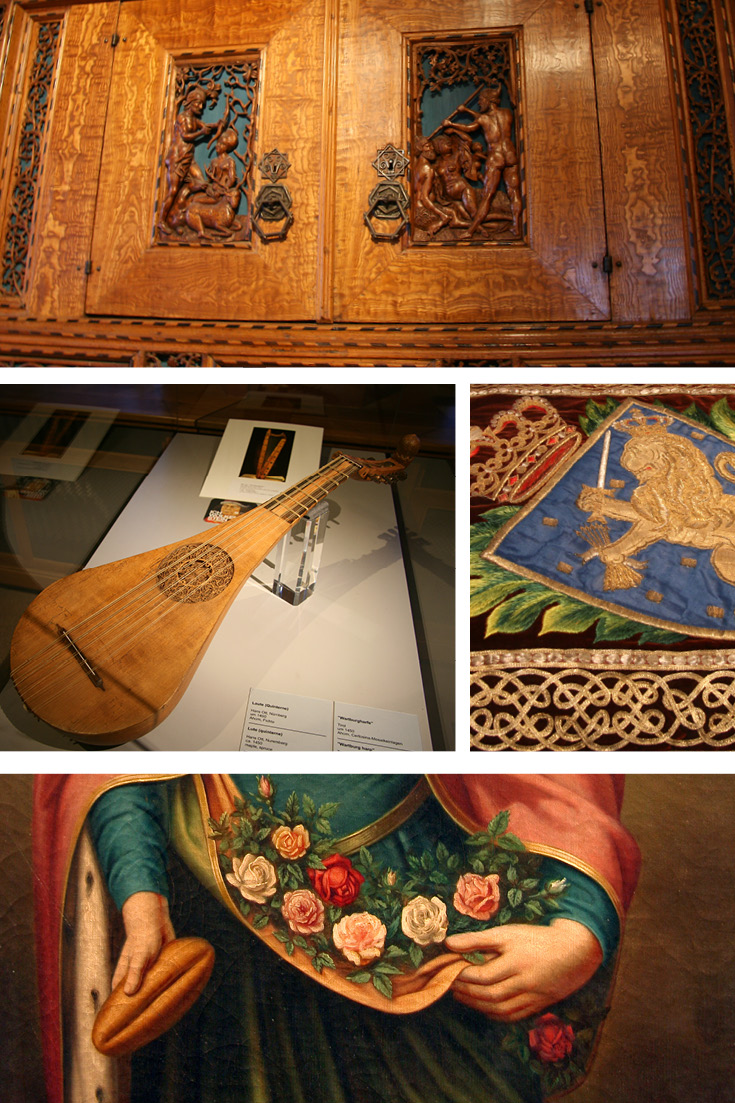
St Elizabeth
First, St Elizabeth lived here for most of her life. What you need to know is that Elizabeth was a Hungarian princess who was betrothed to Ludwig IV of the Ludovingians. She was sent to the castle to be groomed as a wife at age four. She gave everything she could to take care of the poor in the surrounding area. If you’d like to read more about St. Elizabeth and the miracles associated with her, click here and you’ll be redirected to a Catholic Encyclopedia article.
The Refuge of Martin Luther
The second reason the Wartburg is a religious destination, is because Martin Luther found refuge here. You can visit the room where he stayed. This is the place where he did some of his life’s best works and translated the New Testament from Greek to German. The castle is fortunate to have a copy from 1541 that belonged to Wolfgang Wesemer with an inscription on the inside cover by Luther himself and his collaborator Philipp Melanchthon.
1817 Wartburg Festival
Four years after the Battle of Nations in 1813, and the 300th anniversary of the Lutheran Reformation, student corporations met in Eisenach and marched to the Wartburg. They hosted speeches and symbolically burnt items. Five hundred students marched for the creation of a unified German Empire. It is said that one of the fraternity flags from the city of Jena that was carried during the march became the inspiration for the final German flag. You can read more about the stories behind the German flag in our earlier article here.
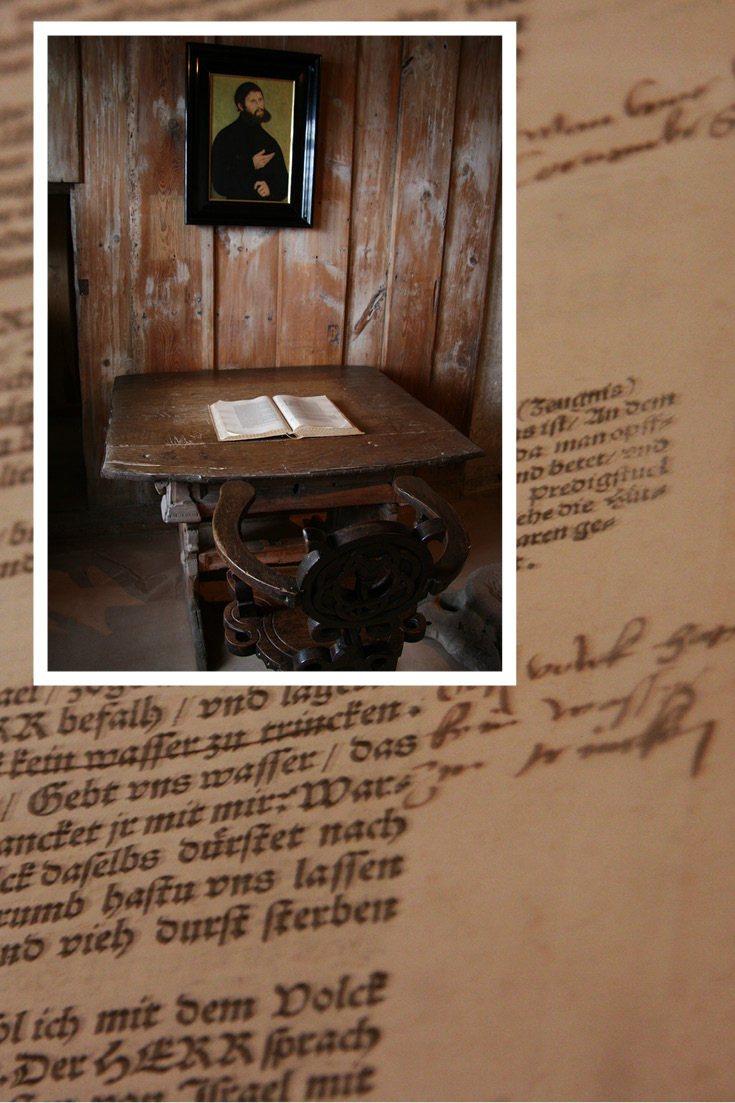
Historicism
Historicism is architecture inspired by and recreates another period’s architecture. In Wartburg Castle’s case, the Romantics were inspired by the medieval architecture and sought to recreate it and expand the castle in the same style. Often, when castles were expanded or renovated, they wanted to replace the out of fashion architecture, in this period they loved it and wanted more of it. Historicist architect Hugo von Ritgen lobbied passionately for the commission to restore and continue building.
Goethe & Museum Treasures
Johann Wolfgang von Goethe was emotionally impacted by the castle’s history; he demonstrated this through his writing, letters, and sketches. He hoped there would be a museum installed within the castle that would inspire even more pilgrims to visit. Inspired by Goethe’s idea for a museum and in Goethe’s memory, Grand Duchess Maria Pavlovna and her son Carl Alexander of Saxe-Weimar-Eisenach, began the process of a European art collection which would focus on the time period of the castle. Today, the Wartburg Art Museum has collected over 1,000 years of European art from the time of Wartburg Castle’s heyday.
Recommended Souvenir From Wartburg Castle
The souvenir to get from Wartburg is definitely the small booklet (60 pages) about the history of the castle, the architecture, and the legend of St. Elizabeth. The Wartburg, Part of the World’s Heritage by Günter Schuchardt, Translated by Margaret Marks. In such a slim, light volume, there’s a wealth of information alongside historical drawings, paintings, and color photos. Without it, I could not write this post with any credible facts.
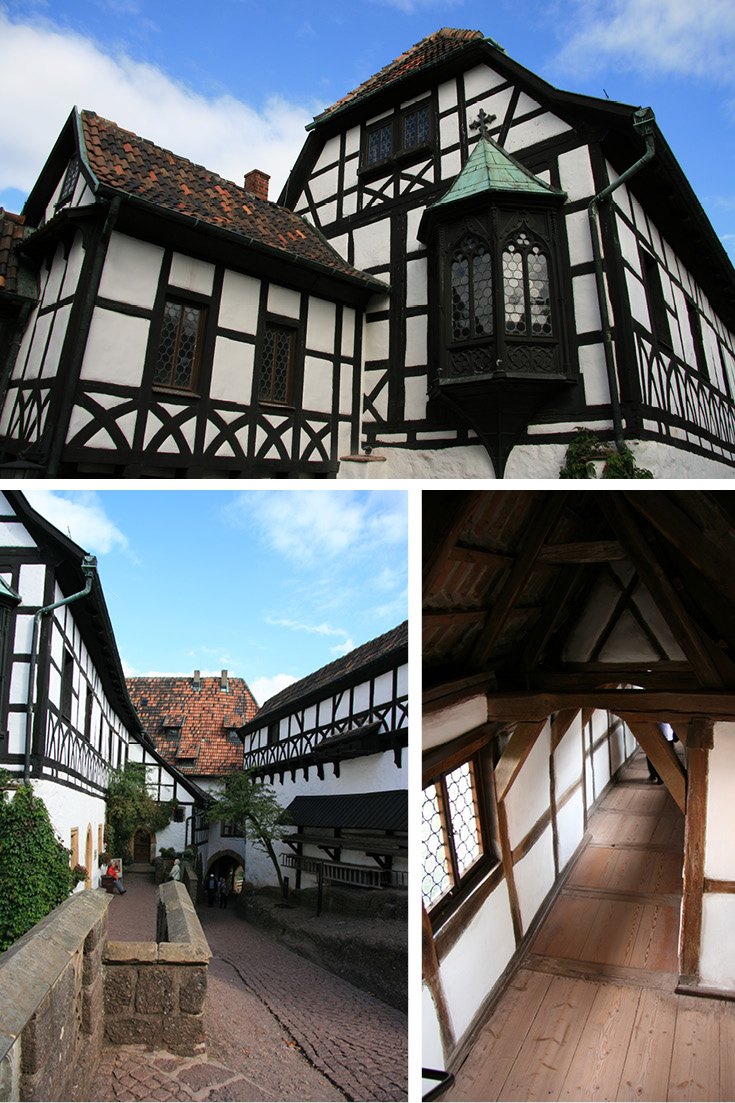
Still want to see more? There's certainly more to see! This is a nice video overview of the castle.
Follow Along
If you enjoyed this article, or these topics sound interesting to you, you'll love our weekly newsletter. You'll receive a free Germany Packing list for signing up, and you'll receive each week's newest posts every Friday. Thank you for reading!

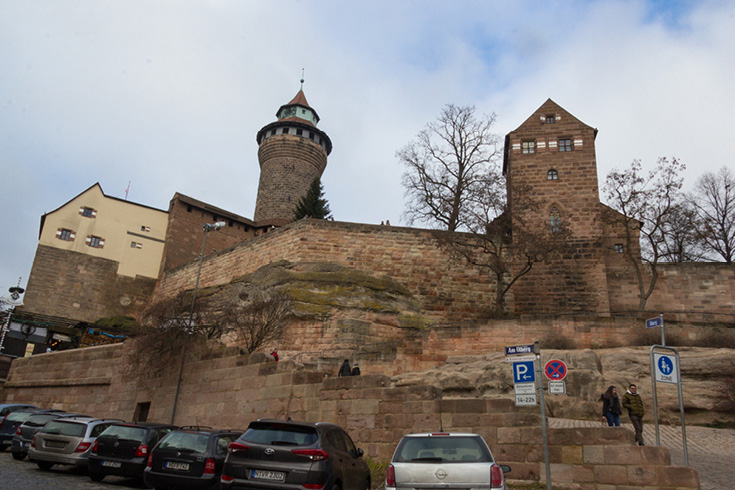
Although the sun was shining brightly, it was bitterly cold as we walked up the steady incline towards the Imperial Castle of Nuremberg. When we reached the base of the castle, a parking lot stood just before it, posing an odd juxtaposition of modern and medieval. We were early, the castle hadn’t opened yet, but there were still school groups already posing for group photos in the frost bitten castle gardens. I admired their youthful daring as they leapt onto craggy rocks for selfies. I was timidly walking on the inclined cobblestones, wondering where the handrail was.
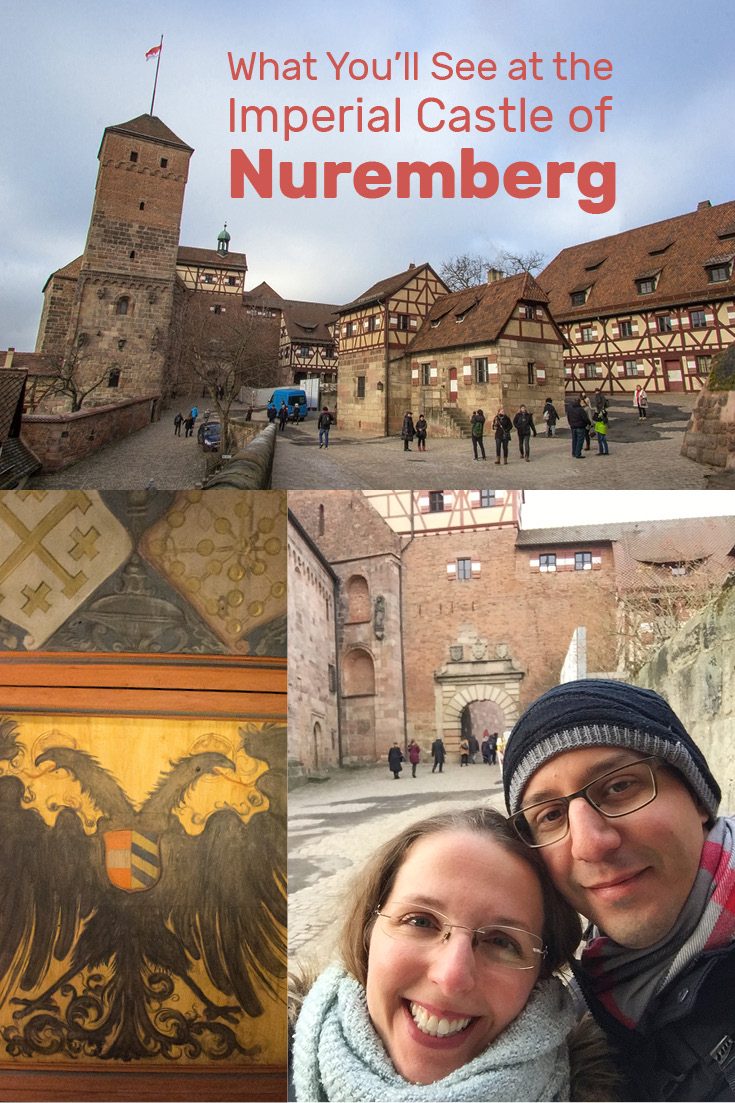
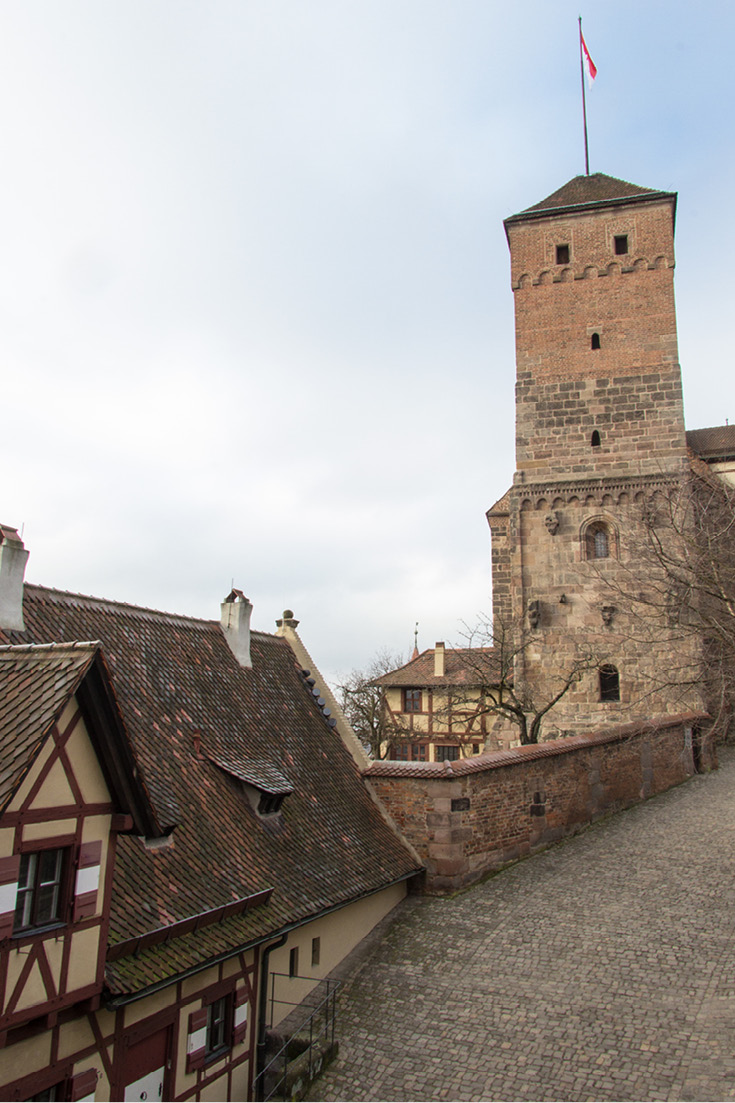
Inner Courtyard & Kunigunden Lime Tree
Sebastian and I were hoping that perhaps the ticket area had a heated waiting area, and ventured in towards the castle’s inner courtyard. After all these years, Germany’s castles still make my jaw drop. I was torn between wanting to take pictures while there were few tourists in the viewfinder, and wanting to find heat. We found the inner courtyard and saw several other like minded couples sitting on frozen benches looking at the Kunigunden lime tree 3.0. The original tree was replaced in 1934, but that planting did not have enough space for the roots between the rocks, and the current tree was planted a few years ago.
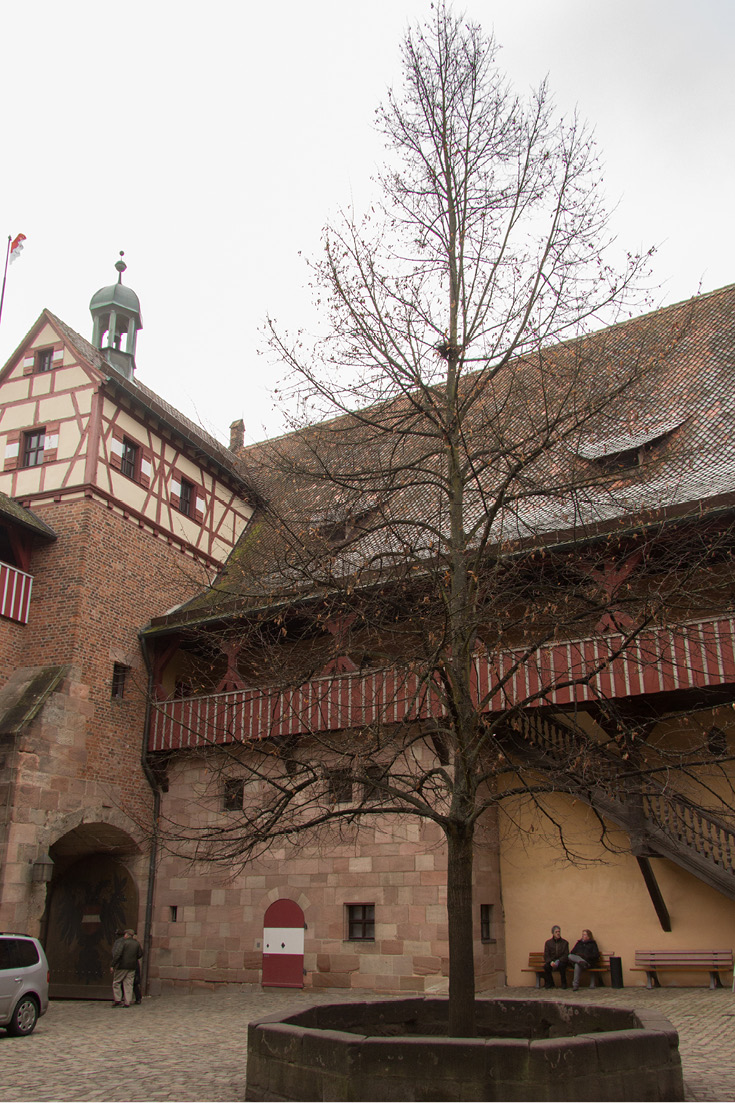
The Legend of the Kunigunden Lime Tree
“The Empress Kunigunde planted it, says the legend, some seven hundred years ago. For once, when King Henry was a-hunting, he came in the pursuit of a deer to the edge of a steep precipice, and this in the heat of the chase he did not perceive, but would have fallen headlong had not a lime-branch, at which he grasped in his extremity, stopped and saved him. And he, recognising the special protection of the Most High, broke off a twig of the lime-tree in remembrance of his wonderful preservation, and brought it to his anxious wife, who planted it at once with her own hands in the earth, and it soon grew into a beautiful tree.” Excerpt From: Cecil Headlam’s “The Story of Nuremberg,” published in 1901 and available for free as part of The Gutenberg Project, click here.
Always punctual, an elderly German gentleman walks slowly with keys jingling in hand towards the ticket office. Our cold colleagues started to gather behind him. We bought our tickets, and went back out to the inner courtyard to enter through the Knight’s Hall. It was an expansive stone room devoid of furniture. On the wall with the windows overlooking Nuremberg, there was a moving illustrated border wallpaper of the imperial processional. I looked around and wondered how we would get into the next exhibit, as the only door in the hall was so impressive and authentic looking there was no way it was intended for our use. It receded into the wall with a pointed arch, and being at the top of a few steps it seemed so tiny. All around the door frame was a gothic mural of Emperors on either side, and Christ on the cross over the top of the arch. When someone else reached for the door handle, I still hung back, suspicious an alarm would sound. Instead, only an obnoxious squeak from the hinges and a smiling attendant greeted them from the other side of the door.
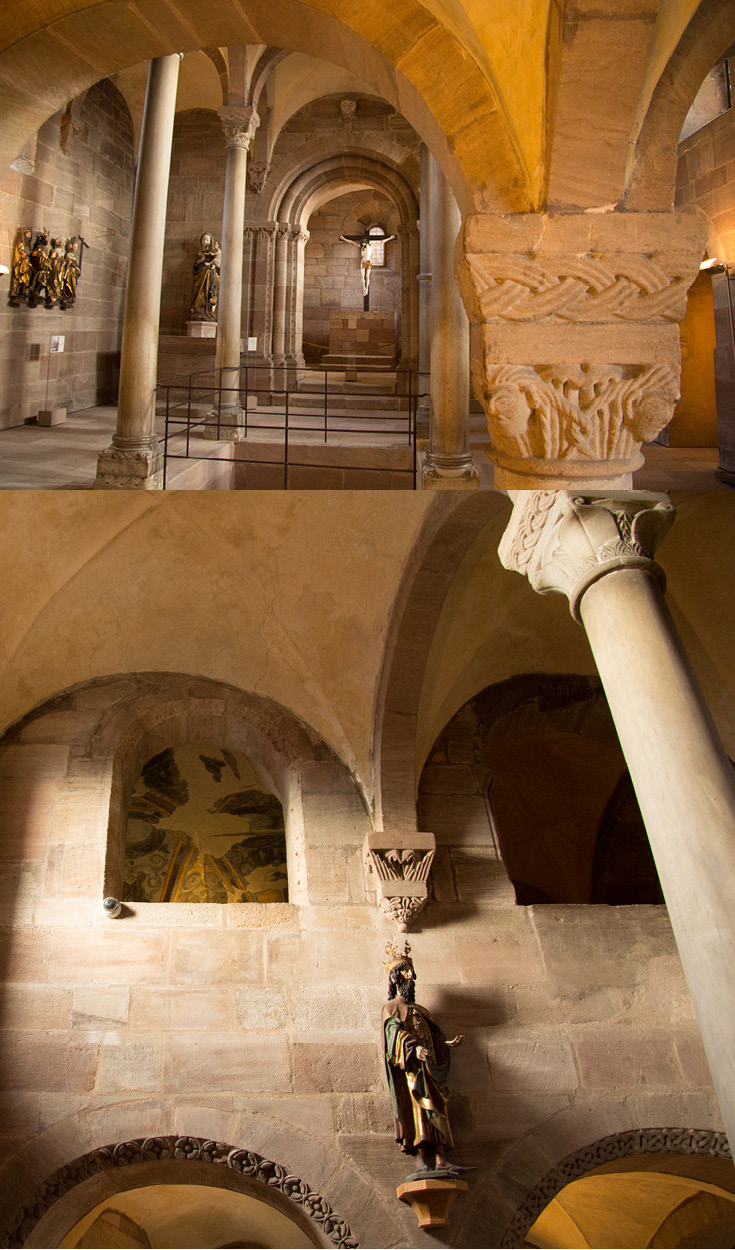
Double Chapel
The door opened to the double chapel, the lower level. It's in the Romanesque style and survived the bombings of WWII for the most part. Graceful, simple columns connect the two levels, the lower for the court, and the upper for the Emperor. You can even peek down below your feet into St. Margaret’s Chapel. It wasn’t accessible to tour. In the back corner we found a stone staircase to continue up to the Emperor's level of the Chapel.
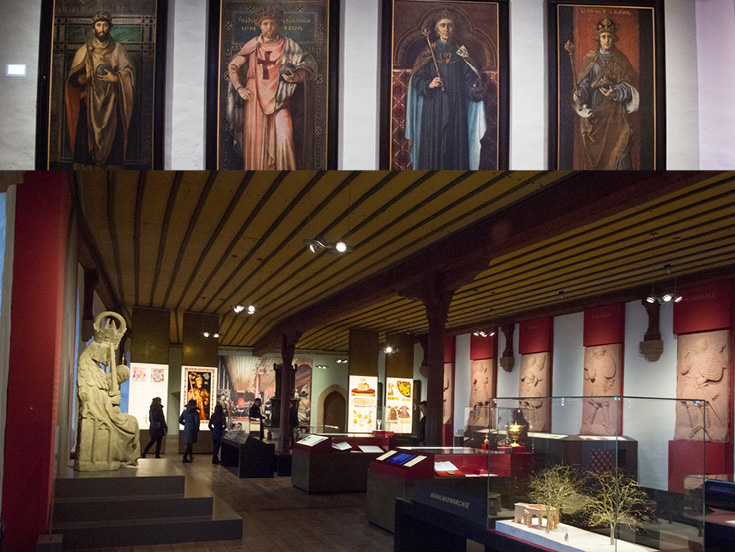
Imperial Hall and Apartment
The next room was by far my favorite. They allocated the space that was the original dining hall for the Emperor and lengthened it an additional third and created a wonderful and modern interactive exhibit space that explains how the Emperors were elected in the Holy Roman Empire. It always seemed a contradiction to me that Emperors were elected, and not inherited. The German lands are unique compared to the United Kingdom and France in this aspect. This exhibit really brought the distinction to clarity to me. Do you understand how Emperors were elected? Let us know in the comments. We may do a post about the process in the future.
Imperial Castle Museum, a branch of the Germanisches Nationalmuseum
After going through a few more smaller rooms of the Imperial Apartment, we stepped into the Bowery. Here was endless artifacts from history, coins, toys, weapons, armor, shields (with deflection marks!), a throne chair, and more.
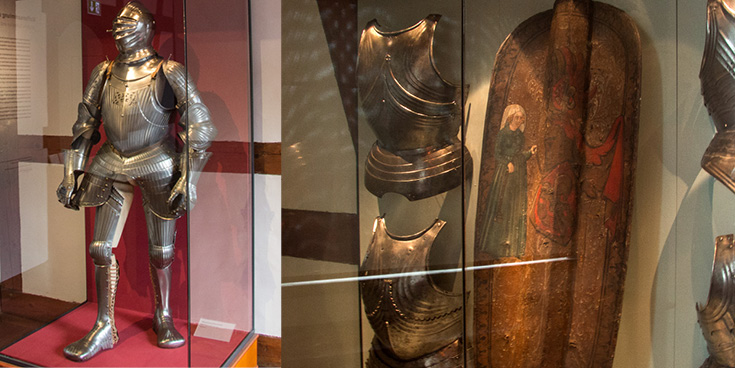
Sinwell Tower & Deep Well
If you’re not opposed to steps or heights, definitely climb Sinwell Tower. The view of Nuremberg is fantastic, and they have black and white photos of how the city looked after WWII for comparison.
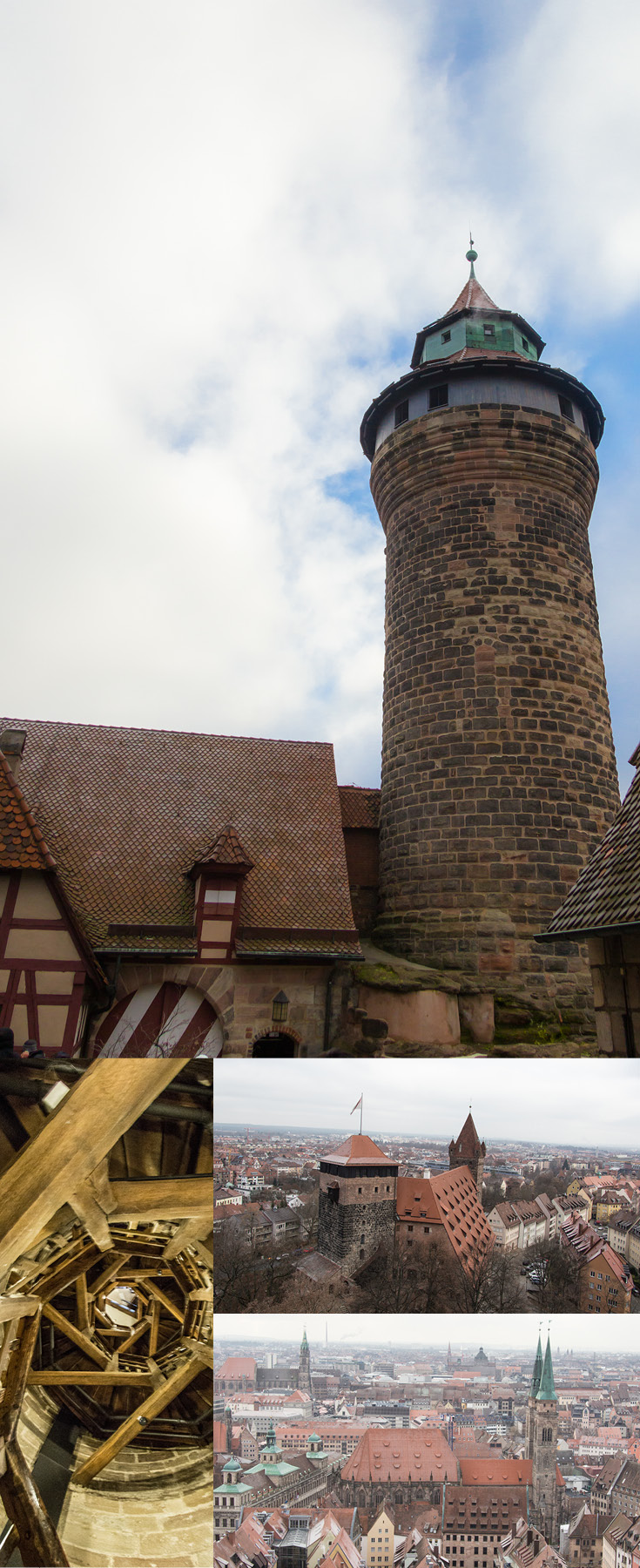
For the Deep Well, you visit with a guide at assigned times, and yes it is more than a really deep hole in the ground. The guide pours water down the well so you can hear how long it takes for the water to splash. Then the guide lowers a candle all the way to the bottom with a video camera all while sharing the history of the well. It was really interesting and definitely worth the time.
Planning Your Trip to the Imperial Castle of Nuremberg
To do everything, tickets are 7 Euros. You can choose your own adventure and visit for less. Walking through the courtyards and gardens is free. Audio guides are an additional 2 Euros. Prices subject to change. Be sure to check the website for the most up to date prices and hours.
Imperial Castle of Nuremberg Admission Prices
Imperial Castle of Nuremberg Opening Hours
Printable English Brochure
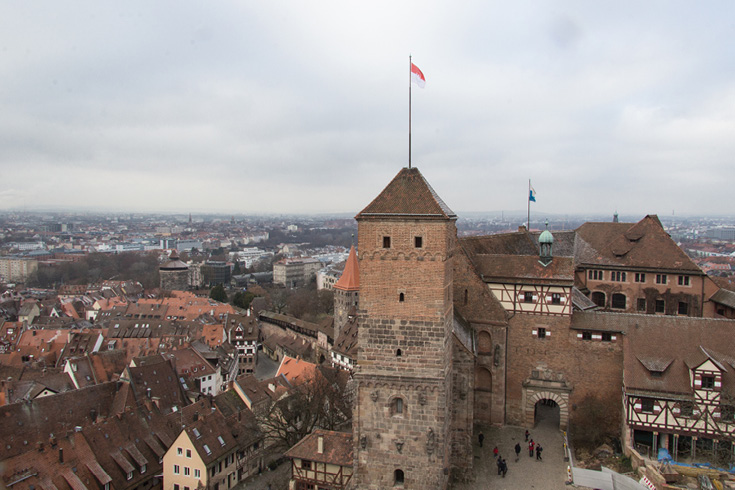
Follow Along
If you enjoyed this article, or these topics sound interesting to you, you'll love our weekly newsletter. You'll receive a free Germany Packing list for signing up, and you'll receive each week's newest posts every Friday. Thank you for reading!

